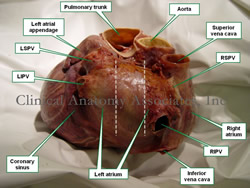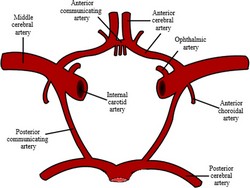
Medical Terminology Daily (MTD) is a blog sponsored by Clinical Anatomy Associates, Inc. as a service to the medical community. We post anatomical, medical or surgical terms, their meaning and usage, as well as biographical notes on anatomists, surgeons, and researchers through the ages. Be warned that some of the images used depict human anatomical specimens.
You are welcome to submit questions and suggestions using our "Contact Us" form. The information on this blog follows the terms on our "Privacy and Security Statement" and cannot be construed as medical guidance or instructions for treatment.
We have 524 guests online

Jean George Bachmann
(1877 – 1959)
French physician–physiologist whose experimental work in the early twentieth century provided the first clear functional description of a preferential interatrial conduction pathway. This structure, eponymically named “Bachmann’s bundle”, plays a central role in normal atrial activation and in the pathophysiology of interatrial block and atrial arrhythmias.
As a young man, Bachmann served as a merchant sailor, crossing the Atlantic multiple times. He emigrated to the United States in 1902 and earned his medical degree at the top of his class from Jefferson Medical College in Philadelphia in 1907. He stayed at this Medical College as a demonstrator and physiologist. In 1910, he joined Emory University in Atlanta. Between 1917 -1918 he served as a medical officer in the US Army. He retired from Emory in 1947 and continued his private medical practice until his death in 1959.
On the personal side, Bachmann was a man of many talents: a polyglot, he was fluent in German, French, Spanish and English. He was a chef in his own right and occasionally worked as a chef in international hotels. In fact, he paid his tuition at Jefferson Medical College, working both as a chef and as a language tutor.
The intrinsic cardiac conduction system was a major focus of cardiovascular research in the late nineteenth and early twentieth centuries. The atrioventricular (AV) node was discovered and described by Sunao Tawara and Karl Albert Aschoff in 1906, and the sinoatrial node by Arthur Keith and Martin Flack in 1907.
While the connections that distribute the electrical impulse from the AV node to the ventricles were known through the works of Wilhelm His Jr, in 1893 and Jan Evangelista Purkinje in 1839, the mechanism by which electrical impulses spread between the atria remained uncertain.
In 1916 Bachmann published a paper titled “The Inter-Auricular Time Interval” in the American Journal of Physiology. Bachmann measured activation times between the right and left atria and demonstrated that interruption of a distinct anterior interatrial muscular band resulted in delayed left atrial activation. He concluded that this band constituted the principal route for rapid interatrial conduction.
Subsequent anatomical and electrophysiological studies confirmed the importance of the structure described by Bachmann, which came to bear his name. Bachmann’s bundle is now recognized as a key determinant of atrial activation patterns, and its dysfunction is associated with interatrial block, atrial fibrillation, and abnormal P-wave morphology. His work remains foundational in both basic cardiac anatomy and clinical electrophysiology.
Sources and references
1. Bachmann G. “The inter-auricular time interval”. Am J Physiol. 1916;41:309–320.
2. Hurst JW. “Profiles in Cardiology: Jean George Bachmann (1877–1959)”. Clin Cardiol. 1987;10:185–187.
3. Lemery R, Guiraudon G, Veinot JP. “Anatomic description of Bachmann’s bundle and its relation to the atrial septum”. Am J Cardiol. 2003;91:148–152.
4. "Remembering the canonical discoverers of the core components of the mammalian cardiac conduction system: Keith and Flack, Aschoff and Tawara, His, and Purkinje" Icilio Cavero and Henry Holzgrefe Advances in Physiology Education 2022 46:4, 549-579.
5. Knol WG, de Vos CB, Crijns HJGM, et al. “The Bachmann bundle and interatrial conduction” Heart Rhythm. 2019;16:127–133.
6. “Iatrogenic biatrial flutter. The role of the Bachmann’s bundle” Constán E.; García F., Linde, A.. Complejo Hospitalario de Jaén, Jaén. Spain
7. Keith A, Flack M. The form and nature of the muscular connections between the primary divisions of the vertebrate heart. J Anat Physiol 41: 172–189, 1907.
"Clinical Anatomy Associates, Inc., and the contributors of "Medical Terminology Daily" wish to thank all individuals who donate their bodies and tissues for the advancement of education and research”.
Click here for more information
- Details
As previously described, the cardiac base is one of the surfaces of the heart, opposite to the cardiac apex.
The cardiac base is formed mostly by the left atrium, which is flanked by the four pulmonary veins. The thoracic esophagus is located posterior to the left atrium, separated from the heart only by the pericardium. This is important for a transesophageal echocarcardiogram (TEE) where there are only soft tissues between the esophageal transducer and the heart. In the accompanying image, two dotted lines show the approximate area of location of the thoracic esophagus.
Other structures that form the cardiac base are a segment of the posterior aspect of the ascending aorta, the superior and inferior vena cavae, and the posterior aspect of the right atrium.
Image property of: Photographer: David M. Klein
- Details
The root term [-clast] arises from the Greek [κλαστός / klastes] meaning "to break". The root term [-clast-] is used in medical terminology to mean "to destroy", or 'to break down". Variations of this term are the suffix [-(o)clasis] and the suffix [-(o)clasia].
A vernacular example of its use is in the word [iconoclast], meaning "to break down icons, images, or idols. Another great example comes from vulcanology (study of volcanoes). The word [pyroclastic] includes the prefix [pyro-] meaning "fire". It refers to a wall of hot gases and ashes spewed from a volcano moving up 450 miles per hour destroying and igniting everything in its path.
Examples of its use in medical terminology are:
- Osteoclast: The root term [-oste-] means "bone". A destroyer of bone
- Osteoclastocyte: The suffix [-(o)cyte-] means "cell". A better way to denote a cell that destroys or breaks down bone
- Osteoclasis: The action of osteoclastocytes
- Details
The root term [-blast] arises from the Greek [blastos] meaning "a germ", "seed" or "a sprout". The equivalent term in Latin is [germen], as in "germination". The root term [-blast-] is used in medical terminology to mean "germinative" and "to build". Because of the connotation of "seed" the term is widely used in embryology. Examples of its use are:
- Osteoblast: The root term [-oste-] means "bone". A bone germinative cell
- Odontoblast: The root term [-odont-] means "tooth". A tooth germinative cell
- Fibroblast: The root term [-fibr-] is used to mean "fiber", referring in this case to collagen and connective tissue. A cell that buils tissue with collagen fibers
- Fibroblastocyte: The suffix [-(o)cyte-] means "cell". A better way to denote a cell that builds tissue with collagen fibers
- Details
The posterior cerebral artery is a bilateral artery with a common origin from the basilar artery at the level of the mesencephalon (midbrain). The basilar artery itself is formed by the junction of both vertebral arteries.
After the common origin of both posterior cerebral arteries, the posterior communicating arteries arise, forming the posterior aspect of the arterial circle of Willis. The posterior cerebral arteries provide blood supply to the medial aspect of the occipital lobe of the brain, as well the inferior and medial aspect of the temporal lobe. It also provides deep arteries to the thalamus and hypothalamus
For information on the anatomical variations of the posterior cerebral artery click here.
Sources:
1. "An Overview of Intracranial Aneurysms" Keedy, A Mcgill J Med. 2006 July; 9(2): 141–146
2. "Observations on the length and diameter of the arteries forming the circle of Willis" Kamath S 1981 J Anat 133; 3:419-423"
Image in the public domain, modified from the original courtesy of Wikipedia.
- Details
The suffix [-(o)ptosis] arises from the Greek [πτώσηι?] meaning "to fall", "to sag" or "go down". This suffix is used in medical words such as:
- Nephroptosis: The root term [-nephr-] means "kidney". A falling or drooping of a kidney
- Blepharoptosis: The root term [-blephr-] means "eyelid". A falling or drooping of an eyelid
- Hysteroptosis: The root term [-hyster-] is used to mean "uterus". A falling, drooping, or prolapse of the uterus
- Gastroptosis: The root term [-gastr-] means "stomach". A drooping or sagging of the stomach
- Details
This article is part of the series "A Moment in History" where we honor those who have contributed to the growth of medical knowledge in the areas of anatomy, medicine, surgery, and medical research.

Henry Gray F.R.S
Henry Gray F.R.S. (1827 – 1861). English anatomist, Henry Gray was born in 1827. Not much is known of his early studies. What is known is that on May 6, 1845 Gray was studying as a pupil at St. George’s Hospital in London. At 21 years of age Gray won an award for an anatomical paper on human and comparative anatomy of the eye and its appendages.
In 1850 Henry Gray was appointed as house surgeon to the St. George’s Hospital, and in 1852 he was elected as a Fellow of the Royal Society. He wrote several anatomical papers and in 1852 became a lecturer on Anatomy at the same hospital.
At this time he started work on what would become his legacy to the world. A systematic analysis and treatise on human anatomy that was originally published in 1858, entitled “Anatomy, Descriptive, and Surgical” which was profusely illustrated by Henry Vandyke Carter, M.D.
Unfortunately for the world, Henry Gray was affected by smallpox and died on June 13, 1861 shortly after he was elected as a member of the Royal College of Surgeons. Henry Gray died when he was only 34 years old.
Much of the original work of Henry Gray is today in the public domain. Still, the book that he published is still in print, much modified, but with the same educational purpose. The 40th British Edition of “Gray’s Anatomy: The Anatomical Basis of Clinical Practice” was published in November 2008. The American Edition of the same book was published in 1908, long after his death. The 30thAmerican Edition of Gray’s Anatomy was last published in the USA in 1984.
Sources:
1. “Henry Gray and Henry Vandyke Carter: Creators of a Famous Textbook" Roberts, S. J Med Biog 2000 8: 206-212
2. "Henry Gray, Anatomist: An Appreciation" Boland, F Am J Med Sci 1908 1827-1924
3. "The Anatomist: A True Story of Gray’s Anatomy" Hayes, B. Random House PG 2007



